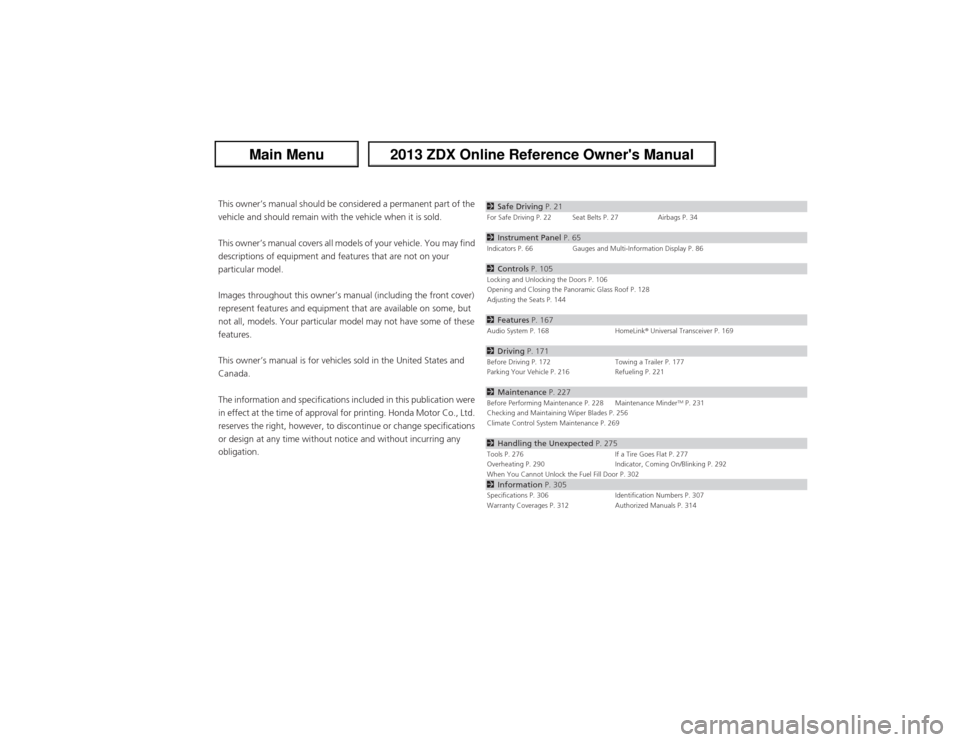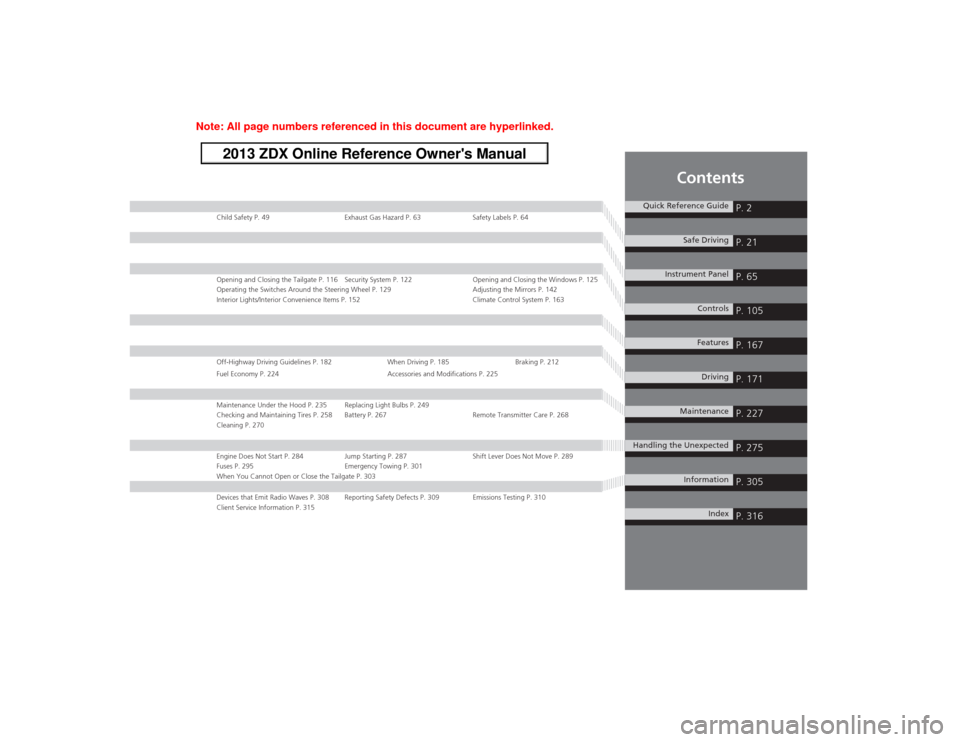Page 1 of 324

ContentsThis owner’s manual should be considered a permanent part of the
vehicle and should remain with the vehicle when it is sold.
This owner’s manual covers all models of your vehicle. You may find
descriptions of equipment and features that are not on your
particular model.
Images throughout this owner’s manual (including the front cover)
represent features and equipment that are available on some, but
not all, models. Your particular model may not have some of these
features.
This owner’s manual is for vehicles sold in the United States and
Canada.
The information and specifications included in this publication were
in effect at the time of approval for printing. Honda Motor Co., Ltd.
reserves the right, however, to discontinue or change specifications
or design at any time without notice and without incurring any
obligation.
2Safe Driving P. 21For Safe Driving P. 22 Seat Belts P. 27 Airbags P. 342Instrument Panel P. 65Indicators P. 66 Gauges and Multi-Information Display P. 862Controls P. 105Locking and Unlocking the Doors P. 106
Opening and Closing the Panoramic Glass Roof P. 128
Adjusting the Seats P. 1442Features P. 167Audio System P. 168 HomeLink® Universal Transceiver P. 1692Driving P. 171Before Driving P. 172 Towing a Trailer P. 177
Parking Your Vehicle P. 216 Refueling P. 2212Maintenance P. 227Before Performing Maintenance P. 228 Maintenance Minder
TM P. 231
Checking and Maintaining Wiper Blades P. 256
Climate Control System Maintenance P. 269
2Handling the Unexpected P. 275Tools P. 276 If a Tire Goes Flat P. 277
Overheating P. 290 Indicator, Coming On/Blinking P. 292
When You Cannot Unlock the Fuel Fill Door P. 3022Information P. 305Specifications P. 306 Identification Numbers P. 307
Warranty Coverages P. 312 Authorized Manuals P. 314
Page 2 of 324

Contents
Child Safety P. 49 Exhaust Gas Hazard P. 63 Safety Labels P. 64Opening and Closing the Tailgate P. 116 Security System P. 122 Opening and Closing the Windows P. 125
Operating the Switches Around the Steering Wheel P. 129 Adjusting the Mirrors P. 142
Interior Lights/Interior Convenience Items P. 152 Climate Control System P. 163Off-Highway Driving Guidelines P. 182 When Driving P. 185 Braking P. 212
Fuel Economy P. 224 Accessories and Modifications P. 225Maintenance Under the Hood P. 235 Replacing Light Bulbs P. 249
Checking and Maintaining Tires P. 258 Battery P. 267 Remote Transmitter Care P. 268
Cleaning P. 270Engine Does Not Start P. 284 Jump Starting P. 287 Shift Lever Does Not Move P. 289
Fuses P. 295 Emergency Towing P. 301
When You Cannot Open or Close the Tailgate P. 303Devices that Emit Radio Waves P. 308 Reporting Safety Defects P. 309 Emissions Testing P. 310
Client Service Information P. 315
Quick Reference Guide
P. 2
Safe Driving
P. 21
Instrument Panel
P. 65
Controls
P. 105
Features
P. 167
Driving
P. 171
Maintenance
P. 227
Handling the Unexpected
P. 275
Information
P. 305
Index
P. 316
Page 10 of 324
9Quick Reference Guide
Controls
(P105)
Clock The navigation system receives signals from
GPS satellites, updating the clock
automatically.Turn Signals
(P132)
LeftRightTurn Signal Control Lever
ENGINE START/STOP
Button
(P129)
Press the button to change the vehicle’s
power mode.
Lights
(P132)
Light Control Switches
High Beam
Low
Beam
Flashing
Wipers and Washers
(P135)
Wiper/Washer Control Lever
Adjustment Ring
: Long Delay
: Short DelayMIST
OFF
INT: Low speed with intermittent
LO: Low speed wipe
HI: High speed wipePull toward
you to spray
washer
fluid.
Page 16 of 324
Quick Reference Guide15
Handling the Unexpected
(P275)
Flat Tire
(P277)
●Park in a safe location and replace the
flat tire with the compact spare tire
located under the cargo area.
Indicators Come On
(P292)
●Identify the indicator and consult the
owner’s manual.
Engine Won’t Start
(P284)
●If the battery is dead, jump start using a
booster battery.
Blown Fuse
(P300)
●Check for a blown fuse if an electrical
device does not operate.
Overheating
(P290)
●Park in a safe location. If you do not see
steam under the hood, open the hood,
and let the engine cool down.
Emergency Towing
(P301)
●Call a professional towing service if you
need to tow your vehicle.
Page 40 of 324

39
uuAirbagsuFront Airbags (SRS)
Continued
Safe Driving
■When front airbags should not deploy
Minor frontal crashes: Front airbags were designed to supplement seat belts and
help save lives, not to prevent minor scrapes, or even broken bones that might occur
during a less than moderate-to-severe frontal crash.
Side impacts: Front airbags can provide protection when a sudden deceleration
causes a driver or front passenger to move towards the front of the vehicle. Side
airbags and side curtain airbags have been specifically designed to help reduce the
severity of injuries that can occur during a moderate-to-severe side impact which
can cause the driver or passenger to move towards the side of the vehicle.
Rear impacts: Head restraints and seat belts are your best protection during a rear
impact. Front airbags cannot provide any significant protection and are not designed
to deploy in such collisions.
Rollovers: Seat belts and, in vehicles equipped with a rollover sensor, side airbags
and side curtain airbags offer the best protection in a rollover. Because front airbags
could provide little if any protection, they are not designed to deploy during a
rollover.■When front airbags deploy with little or no visible damage
Because the airbag system senses sudden deceleration, a strong impact to the
vehicle framework or suspension might cause one or more of the airbags to deploy.
Examples include running into a curb, the edge of a hole, or other low fixed object
that causes a sudden deceleration in the vehicle chassis. Since the impact is
underneath the vehicle, damage may not be readily apparent.■When front airbags may not deploy, even though exterior damage
appears severe
Since crushable body parts absorb crash energy during an impact, the amount of
visible damage does not always indicate proper airbag operation. In fact, some
collisions can result in severe damage but no airbag deployment because the airbags
would not have been needed or would not have provided protection even if they
had deployed.
Page 43 of 324
42
uuAirbagsuSide Airbags
Safe Driving
■When a side airbag deploys with little or no visible damage
Because the airbag system senses sudden acceleration, a strong impact to the side
of the vehicle’s framework can cause a side airbag to deploy. In such cases, there
may be little or no damage, but the side impact sensors detected a severe enough
impact to deploy the airbag.■When a side airbag may not deploy, even though visible damage appears
severe
It is possible for a side airbag to not deploy during an impact that results in
apparently severe damage. This can occur when the point of impact was towards
the far front or rear of the vehicle, or when the vehicle’s crushable body parts
absorbed most of the crash energy. In either case, the side airbag would not have
been needed nor provided protection even if it had deployed.
Page 132 of 324

131
uuOperating the Switches Around the Steering WheeluENGINE START/STOP Button
Controls
The keyless access system main switch is in the
glove box. Switch the keyless access system on
or off.
Turning off the keyless access system cancels
all the system features.
To change the power mode, insert the keyless
access remote into the slot while the keyless
access system main switch is off.■When inserting the remote into the slot
Push the keyless access remote with the built-
in key side towards you into the slot until you
hear a click.■When removing the remote from the
slot
Turn off the power mode before removing the
keyless access remote from the slot.
■Keyless Access System On and Off
1Keyless Access System On and Off
If you need to give the key to someone else, remove
the built-in key from the keyless access remote by
pressing the release button, and give the remote as a
valet key.
Keyless Access Remote
System Main Switch■Keyless Access Remote Slot
1Keyless Access Remote Slot
Use the slot if you cannot operate the keyless access
system, or the remote’s battery is weak. Inserting the
keyless access remote into the slot allows for the
ENGINE START/STOP button to operate.
To avoid damaging the slot, do not insert any other
objects into the slot or put a sticker on the keyless
access remote.
Keyless Access
RemoteSlot
Page 136 of 324

135
uuOperating the Switches Around the Steering WheeluWipers and Washers
Continued
Controls
Wipers and Washers
The windshield wipers and washers can be
used when the power mode is in ON.■MIST
The wipers run at high speed until you release
the lever.■Wiper switch (OFF, INT, LO, HI)
Change the wiper switch setting according to
the amount of rain.■Adjusting the delay
Turn the adjustment ring to adjust the wiper
delay.■Washer
Sprays while you pull the lever toward you.
When you release the lever, the wipers make
one more sweep before stopping.
1Wipers and WashersNOTICEDo not use the wipers when the windshield is dry.
The windshield will get scratched, or the rubber
blades will get damaged.NOTICEIn cold weather, the blades may freeze to the
windshield, becoming stuck.
Operating the wipers in this condition may damage
the wipers. Use the defroster to warm the
windshield, then turn the wipers on.
If the vehicle speeds up while the wipers are
operating intermittently, the length of the wipe
interval shortens. When the vehicle starts moving, the
wipers make a single sweep.
When the vehicle speeds up, the wiper operation’s
shortest delay setting ( ) and the LO setting become
the same.
Turn the washers off if no washer fluid comes out.
The pump may get damaged.
Intermittent Time
Adjustment RingPull to
use
washer.MIST
INT: Low speed with
intermittent OFF
LO: Low speed wipe
HI: High speed wipe
Long delay
Short delay